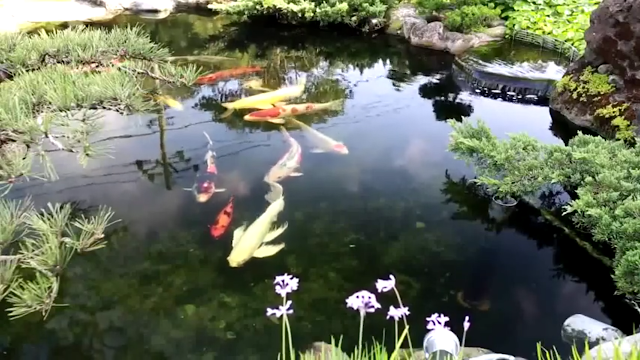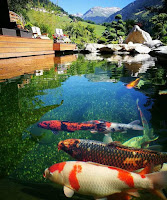Every new Koi that you receive should be quarantined. A Koi can harbor a parasite, bacteria or virus without even showing any symptoms. If you place an un-quarantined Koi in your pond, you risk the well being of your entire collection. Performing a quarantine cycle will keep both the new fish and your existing collection safe. It will also allow you to asses the health condition of the new fish.
- Contents
- Quarantine Tank Setup
- Materials
- Quarantine Procedure
- Examples
Quarantine Tank Setup
The quarantine tank can be a lot smaller than a pond because it will only be a temporary home for the Koi. Most quarantine tanks are 100 to 500 gallons in size. Larger size tanks are impractical for any Koi except the large jumbo varieties. Smaller tanks are also useful for any treatments that could be applied (they are also cheaper to heat).
In addition to the tank, the quarantine setup should also include thefollowing equipment:
- Filter
- Air Pump
- Heater
- Net Tank
- Cover
Filter
The water quality will need to be in pristine condition. The new Koi will be stressed out enough from the move and poor water quality will further its immune system. The filter should be able to be bypassed so it won’t interfere with any treatments. A chemical filter that uses activated carbon can be used, since the tank is only used for a limited time. A biological filter can also be used to clean the water, but the bacteria in it will need to be grown for at least six weeks beforehand in order be able to handle a fish load.
Air Pump
The tank will need a constant supply of fresh oxygen. The air pump should sit above the tank in case of a power failure (If the air pump is installed below the water level, water can siphon back into the air pump and wreck it). A spray bar can also be used to aerate the water, but it will be noisier.
Heater
An aquarium heater should be installed on the tank. It should be large enough to keep the water temperature between 74 and 76 degrees Fahrenheit.
Net
The quarantine tank will need its own net. You do not want to use the same net for the pond and the quarantine tank because of the risk of cross contamination. A pond net may also be too large for practical use in a small quarantine tank.
Tank Cover
The tank should have a net that covers the top to keep the Koi from jumping out. Koi are capricious (jumpy) for up to two weeks when they are introduced into a new environment. A clear piece of acrylic can also be used.
Materials
The following materials are not required, but will help with the quarantine procedure:
- Salt
- Parasite and fungal Treatments
- Tricide-Neo
- Microscope
- Water Test Kit
Quarantine Procedure
Use the following steps to properly quarantine your fish:
Get the quarantine tank up and running. This includes getting the bacteria colonized in the filter and adding 1% (one pound salt per 100 gallons of water) salt to the water. (Make sure the salt is pure rock salt and has no iodine or any water treatment additives.) The water temperature should be 74 to 76 degrees Fahrenheit.
Acclimate the new Koi fish in the quarantine tank.
Cover the tank with the net.
Place a piece of plastic or a piece of pink Styrofoam insulation over the net so the Koi has some shade. This will allow the Koi to feel safer in its new, temporary home.
Test the water parameters daily for the first week. You should test for: temperature, pH, Ammonia, Nitrite and salinity (if salt is added to the water). If they are stable after the first week, you may switch to testing every few days. Test kits can be found at Koi dealers and pet stores.
Don’t feed the Koi for a few days until it has become used to its new surroundings.
Keep an eye on the Koi. It should swim around the tank without scratching its side (also known as flashing). If the Koi is flashing, it may have a parasite infestation. If you suspect that the Koi has a parasite infestation, you can try to treat it with a broad spectrum parasite treatment or you can have a veterinarian that is knowledgeable in freshwater fish care come and examine the Koi. The veterinarian will perform a scraping of the slime coat with a microscope slide and will possibly take a gill snip. The veterinarian will then examine the slide under the microscope to try and identify the parasite that is afflicting the Koi. Once the parasite is found, the veterinarian will prescribe a parasite treatment regimen that will get rid of the infestation. If left untreated, the damage caused by the parasites could lead to an infection. Only antibiotics will treat an infection that a Koi is experiencing.
If the Koi is alone, it may hang out near the bottom. This is normal behavior. If it is sitting on the bottom with its fins clamped, it may had a parasite infection
Perform a 25% water change weekly. This can be done all at once or by changing a a small amount of water every day. If you are comfortable, catch the Koi and examine the entire surface of the body. An ulcer may have popped up on its underside, which is impossible to see when viewing the fish from top down. After three weeks and if the Koi fish is large enough, you may want to have a KHV (Koi herpes vius) ELISA test performed. A KHV ELISA test will let you know if the Koi fish has ever been exposed the the virus or if it has been vaccinated for the virus. (Introducing a Koi that has been exposed to KHV into your pond puts your entire collection at risk. If you experience a KHV outbreak, you can lose almost your entire fish population in your pond in a matter of days.) A blood sample is required to perform an ELISA test, if you don’t know how or are uncomfortable with drawing blood, consult a veterinarian. Wait until the test result is back to move the Koi into the pond. If you did not perform a KHV test, but you feel that the Koi is healthy, you may move the Koi out to the pond if the quarantine period is over. Re-acclimate the Koi if the water parameters for the pond and the quarantine tank are too different.
Remember:
Isolate the Koi in the quarantine tank for at least 3 weeks. Do not introduce a sick Koi into your pond even if the quarantine period is over. Putting the rest of your collection in danger and needlessly moving a sick Koi is a terrible idea.
Examples
The two following examples show how having the correct procedure will save you time, money and plenty of headaches when the buy a new Koi.
Rohan
Rohan buys his Koi fish from his local pet shop. He thinks that quarantining his Koi is a waste of time and he places them right into his pond with all of his other fish. He can’t stand the thought of missing out of some beautiful summertime Koi viewing. A week after getting his latest Koi, he notices that some of the Koi in his pond are scratching themselves on the rocks. He calls the pet store and asks if they have any problems with the Koi they had last week, but they deny everything. He goes and purchases some parasite treatment, enough for his entire pond because he doesn’t have a hospital tank.
It takes three weeks, and many trips to the pet store, but his fish stop scratching themselves and start to act normal again. Rohan thinks that his problems are over with, but a couple days later he notices a red mark the Koi he bought a few weeks ago. The red mark is an ulcer, an infection that was brought on by the slime coat and scale damage from the scratching. Rohan breaks down and calls the fish vet. The veterinarian comes out to his house, examines the fish and takes a tissue sample for a susceptibility test. Rohan anxiously waits a few days for the vet to contact him when the test results to come back. The vet prescribes an antibiotic injection regimen that will hopefully get rid of the infection and allow the fish to heal.
2 months later
The antibiotics worked and the fish was saved. It now has a white spot when the skin has covered the wound, but the scales have yet to grow back. Rohan ended up spending most of his summer trying to keep his Koi healthy instead of enjoying them.
Tina
Tina found a Koi fish that she needed to have at the annual Koi show that was hosted by her Koi club. It was a variety that she didn’t have, but needed in order to get one step closer to completing her collection. She brought the Koi home and put it in her quarantine tank. Tina knows the importance of quarantining, a friend of hers lost her entire collection a few years ago. Halfway during the quarantine period, Tina noticed that the new Koi was sitting on the bottom of the tank. She took out her microscope and took a scraping of the slime coat. She found that a few parasites were on her new Koi. She treated the problem with her well stocked Koi medicine cabinet. The parasites were gone after a couple weeks.
Her new Koi was too small to get a KHV test, but she was confident that it was KHV free since she kept the water temperature above 74 degrees during the quarantine period. After the quarantine period was over, Tina released her new Koi into the pond. It immediately joined the group of Koi fish that were swimming all over her pond and she enjoyed them for the rest of the summer with no problems.


























